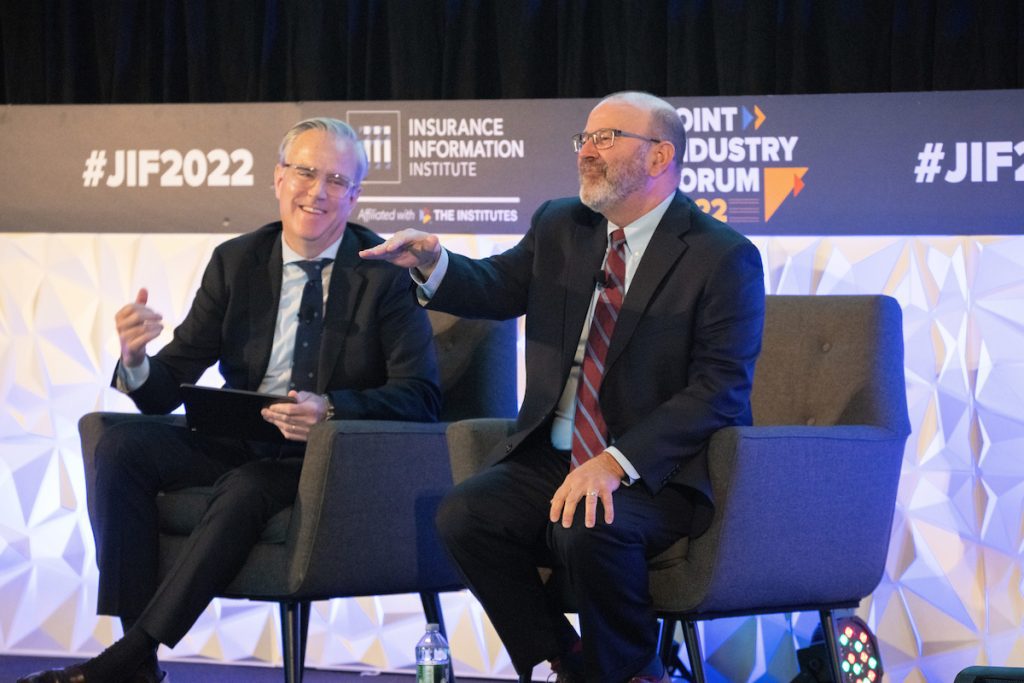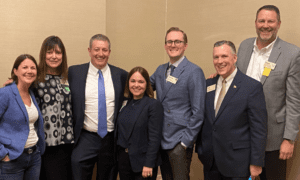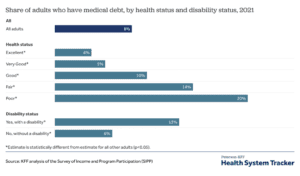JIF 2022: State Farm CEO Talks About the Power and Promise of Mutuality

Photo credit: Don Pollard
State Farm CEO Michael Tipsord discussed a wide range of insurance industry issues and trends with Triple-I CEO Sean Kevelighan at Triple-I’s 2022 Joint Industry Forum. A unifying thread throughout their conversation was the continued relevance of State Farm’s mutual ownership structure and “captive” agent network in today’s risk and operational environment.
State Farm is unusual among large U.S. insurers in that it has retained its mutual structure and continues to rely primarily on a network of more than 19,000 captive agents to sell its products. Founded in 1922 by a farmer who believed farmers shouldn’t have to pay the same auto insurance rates as city dwellers, State Farm has grown to become the largest home and auto insurer in the United States, in terms of market share and premiums written.
The mutual structure – in which policyholders own the insurer – was popular at the time, but in recent decades many mutuals have converted to stockholder-owned companies to access capital needed to grow more quickly.
“This mutual structure permeates everything we do, every decision we make,” Tipsord said. “My focus is always on what’s in the best long-term interests of that State Farm customer group as a whole.”
Mutuality “gives us the flexibility to make choices that our publicly traded counterparts may not think they have,” he explained. “That mutual structure has to be combined with financial strength. Annual operating results are just a means to that end. We’re not subject to the same pressures” as insurers that have to answer to external shareholders.
Similarly, State Farm’s captive agent workforce – located in all but two U.S. states – “are in their communities, day in and day out. They’re in a position to understand their customers because they’re living with their customers.”
Tipsord noted that 95 percent of State Farm’s business comes through its agents, and “we are investing back” into that workforce.
When the pandemic hit and lockdowns commenced, Tipsord said, “Our agents and team members proactively reached out to their customers – not to sell anything, just to check in, to see if they were okay. To see if they needed any help. There are hundreds of stories of agents identifying elderly who needed help buying groceries. It always comes back to our mission of helping people.”
But the success of State Farm’s mutual model and captive agency force doesn’t absolve the company from the need to evolve with changing conditions. State Farm is investing heavily in “digitally enabling our agents,” Tipsord said, “and our agents and their teams readily adapt” to their customers’ expectations.
Part of that digitization effort was State Farm’s recent investment of $1.2 billion in ADT for a 15 percent stake in the home-security company.
“What was most important in that transaction was the relationship that it created among State Farm, ADT, and Google,” Tipsord said. “This is what I call the $300 million opportunity fund. Let’s dedicate resource so we can look for ways in which you bring these three organizations that have very different skill sets together to help our customers.”



